In 2023, Samsung banned AI after staff leaked confidential data via ChatGPT.
Google’s Bard made a factual error that erased $100B from Alphabet’s value.
Harvard expelled students for undisclosed AI use.

Source = Instagram
What do all these failures have in common? They began with someone trusting AI too much without verifying the results.
And now, that blind trust is becoming even riskier. AI-generated writing is no longer easy to spot.
This guide covers five proven methods to identify AI-written content. These techniques work for teachers, administrators, and students who need to know how to tell if AI wrote an essay.
You’ll learn how to use reliable detection tools, spot AI writing patterns, and recognize when essays lack human authenticity.
We’ll show you why AI struggles with personal experiences and what accuracy problems to watch for.
Let’s dive in.
Key Takeaways
- AI detectors like Undetectable AI and GPTZero are helpful, but using multiple tools and your own judgment gives better results.
- AI writes the content in a polished, uniform tone. Real human writing has more natural variation and small imperfections.
- AI can’t fake lived experiences, real emotions, or cultural context convincingly. Look for that human touch.
- Top schools now treat hidden AI use as cheating, with serious consequences like suspension or expulsion.
- Detection tools can misfire, so always keep drafts, notes, and timestamps to defend your original work.
5 Strategies for Identifying AI-Written Essays
When a student hands in something they didn’t actually write, it’s unfair to those who did the work.
Teachers can’t tell what the student knows, and real effort gets ignored.
It also hurts the whole point of learning: to think, write, and grow on your own.
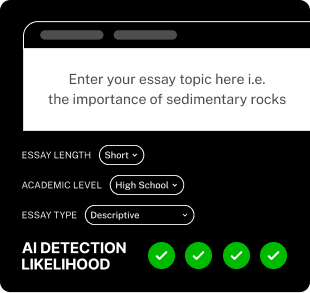

Generate Top-Notch Essays in Seconds. The AI Essay Writer helps you produce essays that will bypass AI detection tools.
- Create Essay Drafts Instantly
- Multiple Writing Styles
- Multilingual Support
Here are top five strategies by which you can identify AI-written content.
Using AI Content Detection Tools
The easiest way to check how to tell if a AI wrote an essay is to use an AI detector.
These tools scan the text and look for patterns that are common in machine writing.
AI tools focus on two key things:
- Perplexity – how predictable the writing is (AI is usually very predictable)
- Burstiness – how varied the sentence lengths and structures are (humans mix it up more)
The key here is to use the top rated and most trustable tools. It’s recommended to use 2 tools for a single piece of content for more clarity.
Here are some popular AI detection tools you can use.
Tested in June by Valstybesinfo, and showed 100% accuracy even on content disguised to look human.
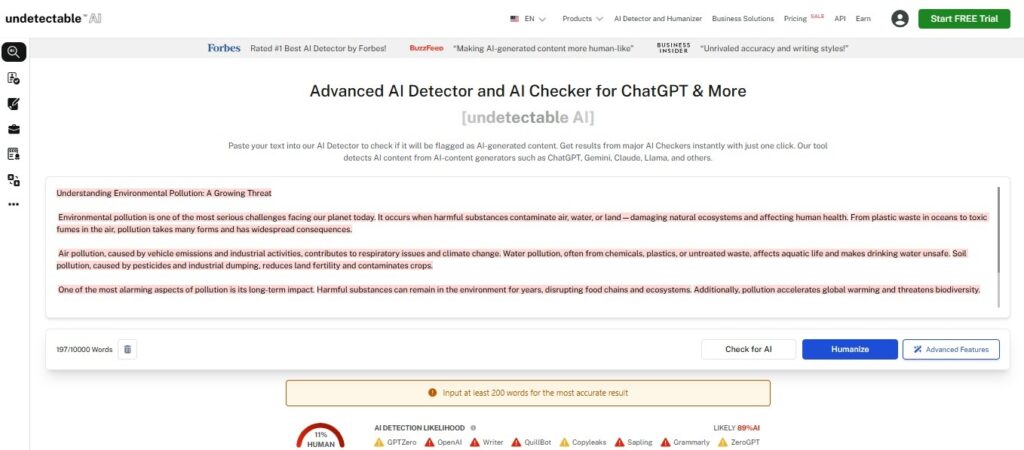
2. GPTZero
Reports 98%+ accuracy on newer AI models like ChatGPT-o1 (based on its own 2024 tests). May struggle with mixed or edited content.
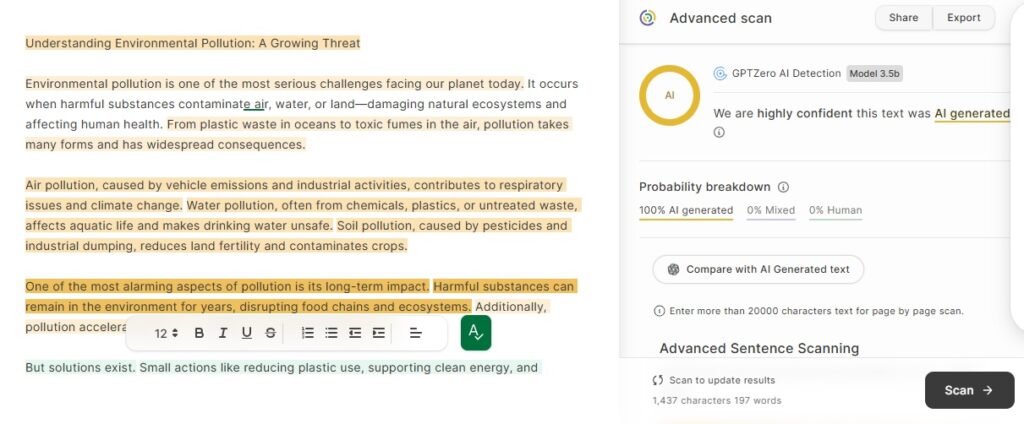
Scored 96–100% accuracy in third-party reviews (including Cornell). Very strong at catching paraphrased AI text. 1–3% false positives.
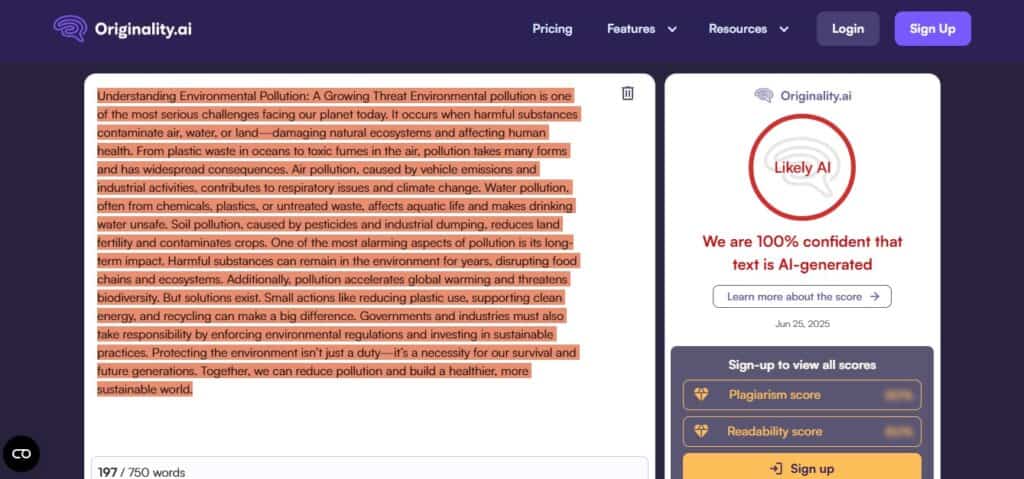
4. Copyleaks
Achieved 99–100% accuracy in university lab tests (Cornell, Adelaide). Less than 1% false positives, even across 30+ languages.
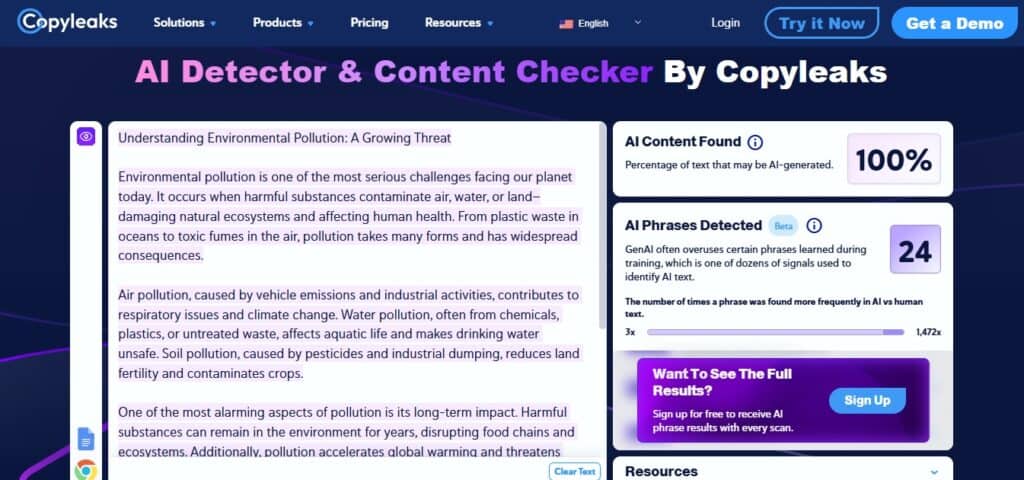
Each of these tools gives you a score or report that shows how much of the content it believes is written by AI.
The tools compare your writing to patterns seen in millions of AI and human-written texts.
Based on that, they give a “probability” score. Here’s how to use a detection tool:
- Copy the essay you want to check.
- Go to one of the tools mentioned above (e.g., Undetectable.ai).
- Paste the text into the input box.
- Click “Analyze” or “Check”.
- Review the score or breakdown it provides.
And yes, these tools like Undetectable AI Humanizer can rewrite AI content in a more human-like way.
They change sentence structure, vary tone, and inject a more natural writing rhythm.
As a result, they often pass these detection tools — even when the content was originally created by AI.
Analyzing Tone and Style
If you’ve used AI for at least a month, you’ll likely be able to identify AI-generated content by analyzing its tone and style. This is one of the most reliable ways to tell if an AI wrote an essay.
AI sounds a little too polished while writing content, like the tone stays formal and steady from start to finish. But human writing feels human and natural.
We might start off serious, then get a bit conversational. Or throw in a joke. Or emphasize a strong opinion with a short, emotional sentence. That kind of variation is hard for AI to mimic.
Take this example:
AI: This phenomenon presents a significant challenge to educational integrity.
Human: This is a real problem — not just for schools, but for every student trying to learn honestly.
Another factor is grammar. AI usually nails at grammar as there are no typos, and no awkward pauses. Every sentence is squeaky clean, and that’s the sign of AI-written content.
People make tiny mistakes because we write like we talk. A missing comma, a run-on sentence, even a casual “you know?” — these are all signs of a human touch.
Same goes for sentence structure. AI sticks to the same rhythm: medium-length sentences, evenly spaced thoughts. Humans don’t do that. We switch it up. Sometimes we ramble. Sometimes we get straight to the point.
The final clue is vocabulary. AIconsistently use complex words, even when simpler ones would feel more natural.
A human might say “help” instead of “assist,” or “get better” instead of “improve.” That balance of casual and formal language is something AI struggles to replicate.
Make AI-Written Titles Sound More Human
If you’ve spotted an AI-generated essay or article, chances are the title gives it away first — it often sounds flat, overly formal, or oddly structured.
With our Undetectable AI’s AI Title Generator, you can instantly rework those robotic-sounding titles into natural, engaging ones that fit human writing style.
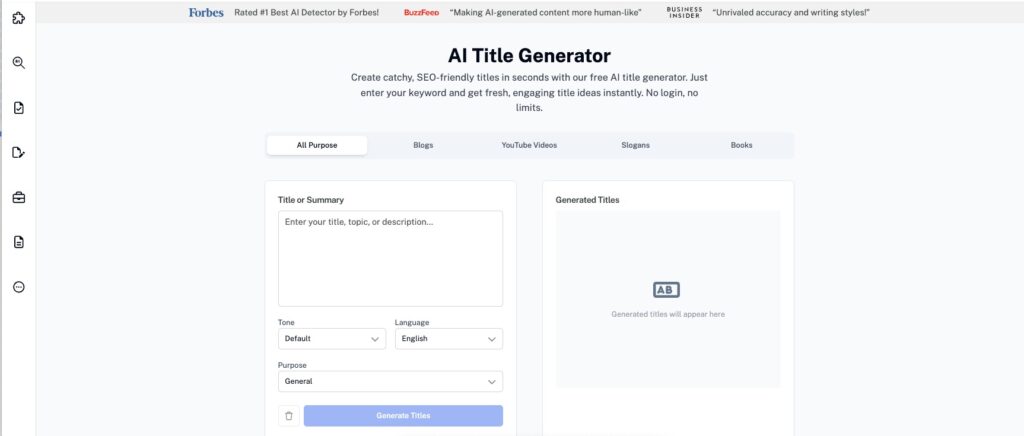
Just drop in your topic or existing AI title, and the tool suggests authentic, audience-friendly alternatives that feel genuine and alive.
Identifying Lack of Personal Touch
AI-written content feels cold, and mechanical. It lacks the human layer that makes an essay relatable and real.
Learning how to tell if AI wrote an essay comes down to spotting this missing personal element.
Think about it, if you were writing something, won’t you try to include personal experience like:
- When I struggled to understand psychology in 11th grade…
- During my summer job at the mechanic shop, I learned…
AI won’t write personal experiences as it has none. Instead, you’ll see something like:
- Students often find psychology difficult and may need additional help.
See the difference? One pulls from life. The other floats in generality.
AI also avoids strong, personal opinions. It tries to stay safe, and neutral. You rarely see bold takes, cultural references, or localized insights.
A human might say,
- In my small Texas town, we…
- As a first-generation college student, I felt…
AI skips those layers. It doesn’t know them. And that absence is noticeable.
Here’s the grammar cue: look for first-person pronouns like I, my, we, and personal markers tied to real moments. These build emotional connections — something AI just can’t fake well.
Undetectable AI changes the norms here. It’s designed to add that missing human feel.
It adds casual phrasing, opinionated lines, and even subtle “memory-like” details that mimic personal experience.
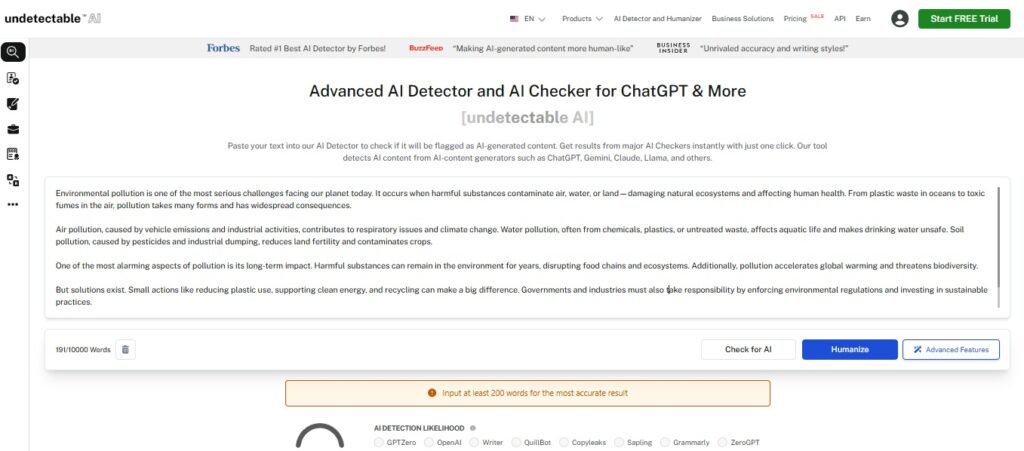
As a result, you get essays that sound lived-in, not just well-written.
Spotting Repetitive Language
AI writing often repeats itself. You’ll start noticing the same phrases popping up, like:
- Furthermore,
- In conclusion,
- It is important to note…
These aren’t wrong, but when they show up in every other paragraph, it’s a clue when you’re trying to figure out how to tell if AI wrote an essay.
AI also loves safety. It fills content with qualifiers like “arguably,” “generally,” or “potentially.”
Because it’s trying not to take a strong stance — it doesn’t “know” the truth, so it hedges over and over.
Another giveaway: repeating sentence patterns. AI tends to use the same construction again and again. For example:
- This shows that…
- This demonstrates…
- It is clear that…
In one AI-generated paragraph, you might see:
- It is important to note the significance of climate change. It is important to note the role of human behavior. It is important to note that global policies are essential.
A human wouldn’t do that. We naturally use synonyms or restructure:
- Climate change matters — not just for the environment, but for our survival. Human behavior plays a massive role, and without policy shifts, we’re in trouble.
See the difference?
Assessing Accuracy and Relevance
Beyond tone and structure, facts are also something which AI trips on. For example:
- As of 2025, the Paris Agreement was signed by 210 countries.
Except that’s wrong. There aren’t even 210 countries in the world.
This happens because AI fills in blanks. It makes guesses based on patterns in older data.
And unless fact-checked, those guesses sneak by.
To catch this:
- Verify names, dates, and numbers.
- Cross-check claims across 2–3 reliable sources.
- Watch for outdated references — like AI citing events “expected in 2023.” That’s a red flag in 2025.
Students usually refer to current topics they’ve heard about. AI might miss that because it doesn’t “know” the news unless it’s fed into its model.
Importance of Distinguishing Human and AI-Crafted Essays
Stanford updated their honor code to include AI misuse. MIT requires students to disclose any AI assistance.
Harvard goes even further – they consider undisclosed AI use equivalent to academic dishonesty, which can lead to suspension or expulsion.
Here are the reasons why it is important to distinguish between human and AI-generated content.
- Protection of Academic Integrity
When a student submits an AI-written essay without saying so, it breaks trust. If one student writes their heart out and another clicks a button, the system would get flawed.
- Prevention of Skill Loss
Writing essays teaches you how to think, argue, research, and express ideas. AI shortcuts that.
Students who rely too heavily on tools like ChatGPT often struggle later when asked to write reports or proposals in real-world jobs.
- Preserving the Value of Education
If we can’t tell who actually wrote the work, how can grades reflect true learning? Teachers can’t give meaningful feedback if the work isn’t real.
Over time, this lowers the standard of education. Students leave school with grades, but not the skills they need.
- Avoiding Professional Consequences
In the workplace, using AI without permission can lead to serious fallout.
A content writer at a digital agency might lose their job when the manager realize every blog post was AI-generated, with zero edits or originality.
- Legal and Ethical Responsibility
Using AI to write work in fields like law, research, or journalism without disclosure isn’t just unethical — it can be illegal.
Think of news articles or medical reports being copied from AI with no fact-checking.
There have already been lawsuits over misinformation published by AI without credit or accuracy checks.
What to Do If You’re Wrongly Accused of Using AI
Getting accused of using AI to cheat (when you didn’t) can be frustrating, and even scary.
But don’t panic as there are clear, calm steps you can take to defend your work and your integrity.

- Document Everything
Start by gathering your materials.
- Do you have the outlines?
- Draft versions?
- Screenshots of your research tabs or notes?
- Even timestamps from Google Docs showing your writing progress can help.
These details show that your essay was written over time, not generated instantly.
- Communicate Early and Clearly
If an instructor flags your work, ask for a meeting, walk them through your process. Tell them where your ideas came from, what sources you used, and how you developed your draft.
- Know Your Rights
Every institution has an appeals process. Use it. You have the right to be heard, to provide evidence, and to challenge automated decisions. Don’t let a tool be judge and jury.
- Use AI the Right Way
If you’re using tools like Undetectable AI, use them ethically. They’re designed to refine what you already wrote.
For example, if you struggle with tone or grammar, the Essay Writer helps smooth robotic phrasing without replacing your ideas. It helps your voice come through more clearly.
So, if you’re ever accused unfairly, you can honestly say: “I used AI to enhance my writing
👉 Use Undetectable AI’s Essay Writer to write smarter.
How to Humanize Your Essays with Undetectable
Using AI to support your writing isn’t cheating — as long as you use it ethically and stay involved in the process.
Tools like Undetectable AI’s Humanizer help you add authentic human expression in your writing.
Here’s how to use it effectively:
- Visit the Undetectable AI Humanizer
- Paste your draft into the Tool
- Choose Your Readability Level
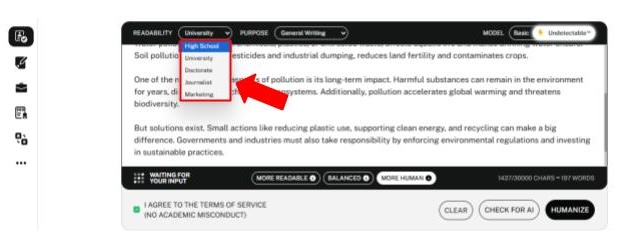
4. Select the Writing Purpose
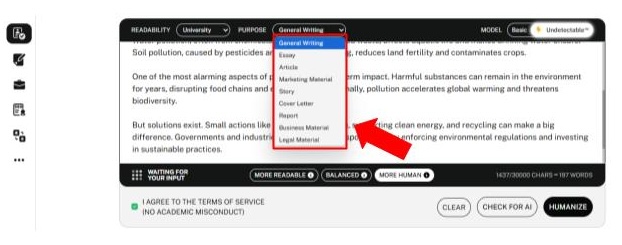
5. Click the “Humanize” Button. Review and refine the draft.
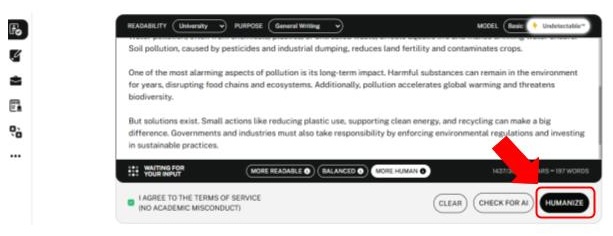
The tool keeps your logic intact but smooths out overly robotic phrasing.
Still — always re-read it and add personal touches if needed. This tool:
- Breaks up the robotic rhythm of AI-generated content.
- Adds contractions, rhetorical questions, and casual phrasing.
- Mimics how humans write when they’re excited, serious, or reflective.
- Easily adds “I believe,” “in my experience,” or “we noticed” markers where appropriate.
Also, we don’t suggest blindly relying on any AI tool. This tool can guide you, but you still have to be mindful of the ethics.
- Never submit something you didn’t review or understand
- Add your personal insights where possible
- Use humanization only on content you created or guided
- Don’t rely 100% on any tool — be involved in the process
Ready to see the difference? Launch our AI Detector and Humanizer in the widget below!
FAQs
How to detect AI writing free?
You can use the free version of Undetectable AI, along with tools like GPTZero or Copyleaks (free tier). Use multiple tools to improve accuracy.
Do teachers know if you used AI to write?
Yes, many teachers can tell. They use AI detectors, but also notice tone shifts, perfect grammar, and unusual formatting. Still, false positives can happen.
What tools detect AI-written essays?
One standout is Undetectable AI Detector, which proved 99–100% accuracy in a third-party review by Valstybesinfo.
It’s designed to spot even humanized AI content, which many tools miss.
Conclusion
In the end, AI isn’t going away. But neither is the need for authentic human thought and expression.
These five detection methods help you in identifying AI-generated content, whether you’re a teacher trying to protect academic integrity or a student wanting to keep your work honest.
Understanding how to tell if AI wrote an essay is becoming an essential skill in our digital age.
Use them together. Trust your gut when something feels off… but always back it up with proof.
The line between “using AI” and “letting AI do the work” is always going to shift. What won’t change is the value of authentic work and honest effort.
Want to use AI without crossing the line?
Try Undetectable AI’s AI Essay Writer — it helps you sound like you, not a robot.
